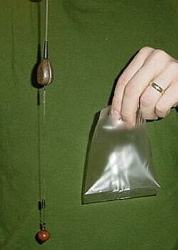Introduction
P.V.A. (Polyvinyl Alcohol) bags are a fantastic way of introducing your hook-bait amongst a small pile of free offerings as described by Martin Sainsbury in his article The Power Of P.V.A.‘.
P.V.A. bags are usually used for short or medium range work, however, used correctly there is no reason why they cannot be use for ranges up to 100 yards.
Tools for the job
To achieve ranges of up to 100yards with a P.V.A. bag you need to have a stiff rod and the use of a shock-leader.
I use a 2.75lb test curve rod, 2oz in-line safety-lead and a 45lb shock-leader, the reason for this is that a full P.V.A. bag can weigh 2oz, add that to the 2oz lead and you have a 4oz casting weight.
A good guide for shock-leader strength is to times the casting weight by ten, i.e. 4oz x 10 = 40lb shock-leader.
Once you are set-up for casting something of that weight you can then prepare the P.V.A. bag, but first choose a good make of P.V.A. bag, poor quality bags will split on the cast spilling your free offerings everywhere.
Preparing the bag
I love to use a pop-up with P.V.A. bags full of Trout-pellets, but it is up to you what you want to go inside your P.V.A. bag, but remember it must be dry.
My chosen hook-link material for P.V.A. bag work is braid, couple this with a pop-up boilie and I have my idea of the perfect presentation, the pop-up boilie being on top of the pile, like the cherry on a cake.
The braid hook-links I use vary between an inch to eight inches in length, some anglers prefer to use a fairly stiff hook-link material that uncoils when the bag melts, but I do not think it makes much difference.

1. Firstly take your chosen hook-bait and a P.V.A. bag, in this case I am using a dipped pop-up boilie.

2. Place your hook-bait in to the corner of the P.V.A. bag.

3. Half fill the P.V.A. bag with some of your free offerings, here I am using different sized trout-pellets.

4. Place your lead in to the bag so that it sits on top of your free offerings making sure that your hook-link is not knotted.

5. Top up the bag with more free offerings to about three-quarters full and then tie up the bag with P.V.A. string around the neck of the bag trapping the lead firmly inside.

6. Push in, then pull out, the corners of the P.V.A. bag, then moisten, fold over and stick down.
Moisten and stick down the frill around the neck on the bag.

7. Use a sharp implement like a boilie needle to prick the P.V.A. bag all over, this will stop the bag from floating and will assist in it dissolving.

8. The finished P.V.A. bag should be tightly packed and circular in shape, this is the perfect aerodynamic shape for a long distance cast.

9. Once in water the P.V.A. bag will melt very quickly leaving your free offerings in a nice little pile with your hook-bait in the center of it.
Conclusion
The first time I tried to reach the 100 yard mark with a P.V.A. bag I was very suprised that the bag stood up to it and did not split.
As I have already stated I use a 2.75lb test curve rod, this will get a P.V.A. bag up to 100 yards without too much of a problem.
However, if you want to achieve extreme distances then I advise that you step up to a larger test curve rod and use a heavier shock-leader, something that I have never tried!
The big bonus with P.V.A. bags is that you can get a neat package out to a fish, at distance, with no tangles and without having to get free offerings out to the same spot after the cast.
I use P.V.A. bags for a lot of my carp fishing and being able to get one up to 100 yards is another string to my bow, after all, it is no good fishing at 50 yards when the fish are at 90 yards.
Tight lines,
Garth ‘Gaffer’ Barnard.








